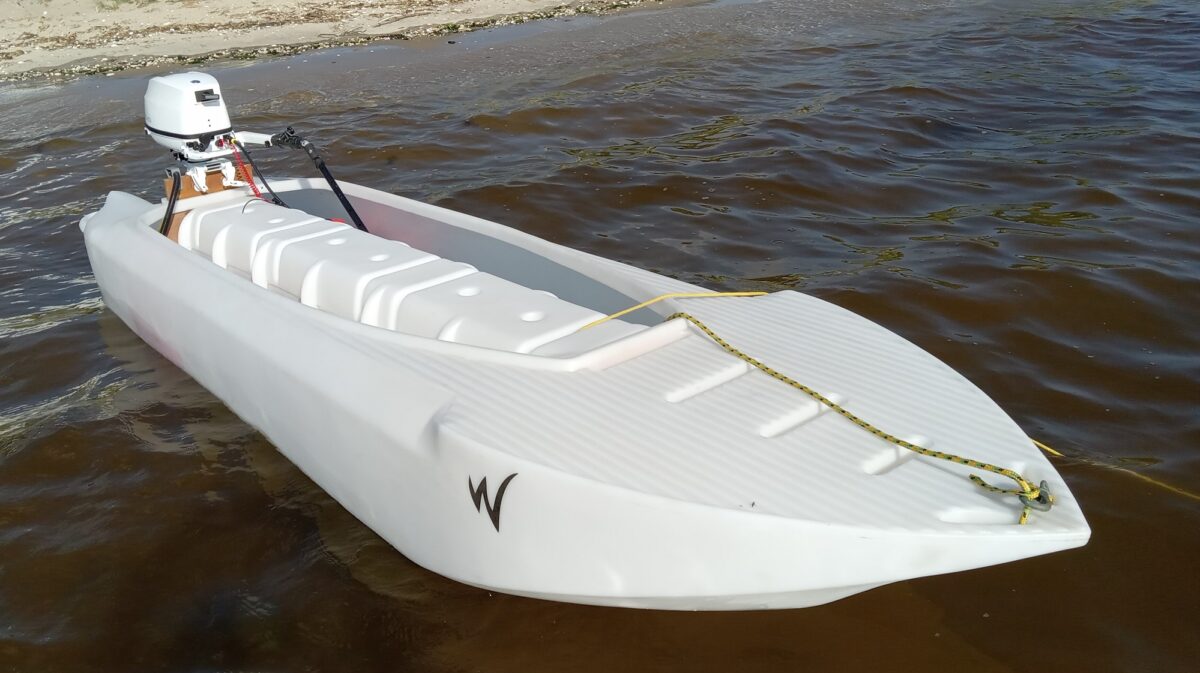This article examines different modes of propulsion available for kayaks today, and discusses their relative advantages and shortcomings.
Different modes of propulsion
Kayaks can be propelled by various means, which include paddling, pedaling, and motorizing*
Most people paddle their kayaks with dual blade (kayak) paddles, and rarely with single-blade (canoe) paddles.
Most pedal drive manufacturers today offer kayaks equipped with rotational drives (rotational pedals and rotational propeller), and one kayak manufacturer offers a pedal drive with push pedals and flapping blades.
Motors for kayaks range from weak electric motors (trolling motors) to powerful outboard gas engines (outboard motors).
Assisted paddling
This is the name given to paddling while an electric motor is working to provide extra power and increase the kayak’s range of travel. Assisted paddling is becoming increasingly popular, especially among kayak anglers whose fishing kayaks are typically not easily to paddle, and are often loaded with heavy fishing gear.
Assisted paddling is particularly useful in moving water (rivers, tidal currents), as well as in big lakes and the ocean.
This hybrid mode of propulsion is particularly useful for paddlers who aren’t necessarily in top physical condition due to weight, age, and physical disabilities.
Pedal drives
For a couple of decades, the niche market for pedal driven kayaks had been dominated by push pedal drives, but it the last few years rotational pedal drives have become increasingly popular in this market, as numerous kayak manufacturers (especially fishing kayaks) started offering kayaks equipped with such drives. This transition is due to the fact that rotational pedal drives for kayaks are more efficient than push pedal ones.
It’s worth remembering that operating pedal driven kayaks is limited to water that’s neither shallow nor rich in vegetation, and a pedal dive won’t get you where a paddle could, which is why pedal kayak users always carry a paddle on board.
From an ergonomic standpoint, the effect of operating a pedal drive is even worse on a person’s back than the effect of paddling a SOT or sit-in kayak, because the continuous horizontal pressure that their legs exert on their lower back while pushing it against the seat’s backrest is bigger than the pressure exerted in a paddling mode in the L position.
Suggested reading –
Paddling
Paddling in the common L kayaking position works for younger people who happen to be physically fit. Such people rarely suffer from back problems, which are the number one cause of disability in America.
For all other people, namely middle aged and elderly, and/or people who are overweight and not in top shape, paddling in the L position is a source of discomfort, pain, and even injuries, hence the expression “yak back”.
Since so many people in America suffer from a sensitive back or from more serious back problems, many anglers view kayaks as uncomfortable boats to fish from, and for a good reason, unless one considers Wavewalk’s patented kayaks, which are back pain free.
Motors
Electric motors
Electric motors are weak, which is why they’re often called trolling motors, namely motors for slow motion.
Having a motor on board is a good thing, as it adds safety in adverse conditions such as wind and current, or paddler fatigue, and it adds to the kayak’s range of travel. However, electric motors fail to deliver the performance that outboard gas engines offer when it comes to power, speed, and long trips.
There are two types of electric motors – Integrated (built-in) motors, and add-on motors that the user attaches to their kayak.
Ironically, the motors purchased separately from the kayak work better than the ones that come already installed in it. The reason for this absurd situation is that it’s easier to mount an electric motor on a kayak in a way that would effectively protect it in case it bumps against the bottom, while integrated motors have no effective protection for such cases. Since every body of water has a bottom, and the distance between the bottom and the surface is not always perceptible or predictable, such unfortunate events are most common. Rocks, fallen trees, oyster beds, coral reefs sand bars and just plain junk are a constant threat to the motor’s propeller and shaft.
Outboard motors
Even small outboard gas engines are too powerful for SOT and sit-in kayaks, including the widest models. Simply, there is no way to outfit a SOT or sit-in kayak with an outboard motor in a sensible manner. Any SOT or sit-in kayak outfitted with an outboard motor is neither comfortable nor safe to drive because of inadequate means to control and steer it.
Wavewalk kayaks are different from SOT and sit-in kayaks in the sense that they offer the user full control over the boat while they drive it, direct access to the motor, and much more stability than any other kayak does.
In fact, the Wavewalk S4 is more seaworthy than most small skiffs and Jon boats, as can be seen in these short videos:
Wavewalk kayaks offer unrivaled stability, and especially the new 13 ft long S4 that allows big and heavy people to drive it without any problem, facing either forward or sideways –
* This article discusses neither kayak sailing nor poling
